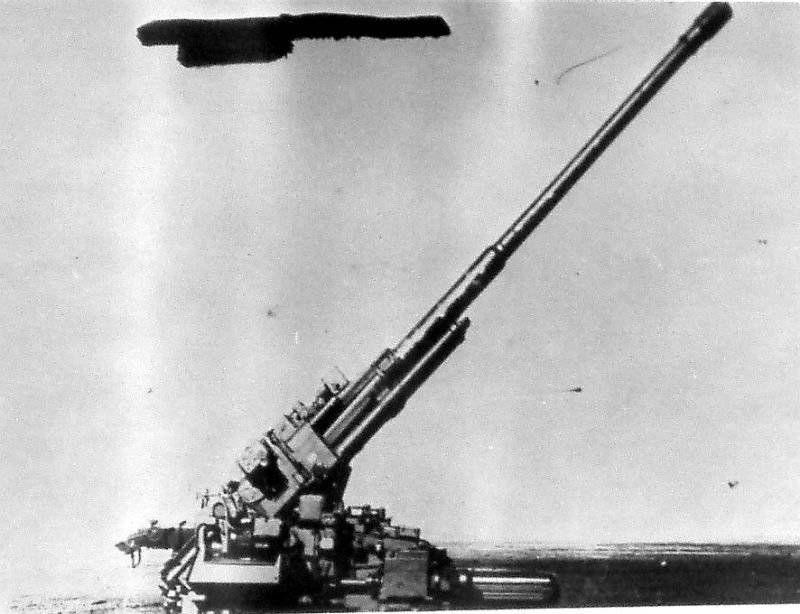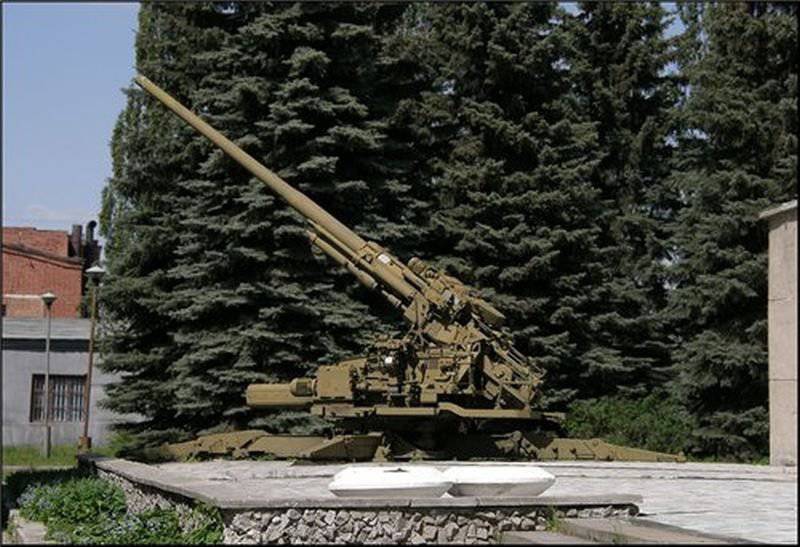The latest Soviet anti-aircraft guns caliber 152mm - KM-52 / КС-52
- firing speed not less than 10 r / min;
- the mass of the used projectile - 49 kilogram;
- total weight of the implement - 46 tons;
- The initial speed of the ammunition - 1030 m / s.
The draft anti-aircraft guns were presented to the technical council, at which representatives of the artillery committee and the ministry of weapons did not approve the project as a whole. In the same year, the project KS-52 was closed, all work on the project was terminated. However, two years later, in 1951, by a resolution of the SM “No. 2966-1127 from 26.11.1951, the topic of creating an anti-aircraft gun of caliber 152mm was revived. The basis for creating a new weapon is the anti-aircraft gun KS-30. The main developer is designate OKB-8 and the design bureau of the plant No. XXUMX. The chief designer of the new project becomes M. Tsyrulnikov.
The new anti-aircraft gun in the course of the work gets the name KM-52. The problems of “redesigning” KS-30 in KM-52 with a large caliber did not make it possible to complete the project before 1954 of the year. The finished project at the end of the year was presented to the technical council of the Ministry of Industry. At the end of January 1955, the project was approved and recommended for production.

The main assembly of the KM-52 was entrusted to plant number 172. The gun barrels were instructed to manufacture the plant number XXUMX. Drives for anti-aircraft guns created by TsNII-8 were manufactured by plant No. 173. Ammunition developed by SRI-710, shell under the shell - SRI-24. The manufacture of ammunition engaged plant number XXUMX. The remaining elements of the shot were made using similar CM-147 shot technologies.
Device and construction
KM-52 equipped with a muzzle brake, the effectiveness of which was 35 percent. The wedge wedge horizontal execution, the shutter work is carried out from the energy of the roll. An anti-aircraft gun was equipped with a hydropneumatic recoil brake and a knurler. The wheel travel with a carriage is a modified version of the KS-30 anti-aircraft gun.
Shot separately-sleeve. For loading the shells and charges from the left to the right, separate loading mechanisms are installed, the mechanisms were operated from electric motors. The store itself is designed as a transporter. Projectiles and charges were fed to certain places of the dismounting line, where they are assembled into a single shot system. After this the shot is sent by a hydropneumatic rammer. The shutter automatically finished preparing the weapon for firing. Used ammunition KM-52 - remote fragmentation grenade. Specify 5655 and No. 3 samples.

Production and Testing
In 1955, deliveries of the first trunks to the main assembly plant began. The first serial model of the KM-52 was assembled by the end of the 1955 of the year. In December, factory testing began, after which the anti-aircraft gun was transferred to the main customer.
Begin basic testing ground. KM-52 showed excellent results of the rate of fire to 17 rds / min., Due to charging mechanisms, additional solutions, optimal design revision. The anti-aircraft gun on the main tests was tested in continuous bursts, the largest - 72 continuous shot. By the 1957, the test batch is made in 16 KM-52 units. They are manning two new anti-aircraft artillery batteries, with a permanent location near Baku. A few months later, an anti-aircraft gun KM-52 offered to adopt.
The fate of KM-52
The anti-aircraft gun caliber 152mm was never taken into service. In the 1958 year, work on the creation of the ARS for the KM-52 anti-aircraft guns is stopped. In addition to the 16 units issued, no more KM-52 units were produced.
There are several versions of why the anti-aircraft gun was never adopted. The first of them is the appearance of jet aircraft that have already developed high speeds and gained great heights. The estimated flight of the KM-52 projectile to the 15 kilometer altitude is about 30 seconds. A jet plane during this time will leave the calculated position at such a distance that the shooting will be completely useless. And to maintain a normal anti-aircraft reflection, would require a huge number of anti-aircraft guns, concentrated in one place. The second version is based on the fact that although the speeds and altitudes of the aircraft grew, they remained rather low-maneuverable high-altitude vehicles and, in principle, it was possible to calculate the necessary point of impact. However, the cost of shots required to destroy one aircraft exceeded its cost. Therefore, applying such a setup would lose in any case. Here it is necessary to take into account the automation of shooting, which would only increase the difference in the cost of shots-plane. In addition, the development of missiles, including anti-aircraft, which, oddly enough, were somewhat cheaper or had a much lower cost of a rocket-plane.
Key Features:
- Length - 8.7 meters;
- vertical pointing angles - 360 degrees;
- weight - 33.5 tons;
- firing speed - up to 17 vist / min;
- distance defeat height / ground - 30 / 33 km;
- height / ground deviation - 205 / 115 meters;
- combat crew - 12 people;
- ammunition weight: projectile / charge / total - 49 / 23.9 / 93.5 kilogram;
- projectile speed - 1000 m.
Information sources:
http://www.russianarms.ru/forum/index.php?topic=3496.0
http://raigap.livejournal.com/170396.html
http://strangernn.livejournal.com/540173.html
Information